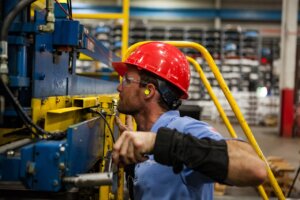Direct Gravure Coating: What’s The Difference?

Moreover, if you’re searching for a gravure coating machine, these tips will help you narrow down what you need.
Why do we utilize gravure coating?
Typically, we use gravure coating to create thin films often with different patterns or designs. Gravure coating is a tinting and coating transfer method which enables us to control the amount of coating distributed to a web. In turn, this allows us to control the thickness of the coating, as well as the ultimate effect of the patterns.
What is the process of direct gravure coating?
So, how does direct gravure coating work in the first place? It’s not simple (though the direct procedure remains the most basic form of the gravure method). But don’t worry, we’ll walk you through it. A gravure coater (naturally an important part of the process!) is what we call a roll coater. You’ll find many different variations of roll coating. In the case of a gravure coating project, we apply resin to an engraved roll. Usually, we then use a blade to scrape the resin off a roll. Why? Because this is the most efficient way to ensure that we have the appropriate amount of resin in the roll. Afterward, we transfer that resin remaining on the engraved roll onto a substrate. Ultimately, we’re left with a new film.
Let’s return to the concept of variations—we vary the process based on changes, whether that’s through the configuration of the roll, the blade structure, or the transfer method. We use all of these variations, typically, for thin coating projects. With all of them, we work with high speed and versatility, which makes gravure coating even more valuable among manufacturers.
What is the difference between direct gravure and reverse gravure?
When considering popular alternatives to direct gravure coating, you’ll inevitably come across reverse gravure coating. While the two processes share similarities, they also have distinct qualities and benefits, as well as potential pitfalls. The process you ultimately select may depend on factors related to your individual project, as opposed to pros and cons of the process itself.
Let’s consider direct gravure coating first. Specifically, the direct gravure process works with low viscosity coating applications and low coating amounts. However, another important distinction involves the web passing between the gravure roll (the engraved roll) and the backup roll. With the direct process, both rolls travel with the web.
In contrast, with reverse gravure coating we shear the engraved roll against the web. Why might you choose this process over the more straightforward direct gravure coating? Well, for one thing, the reverse process actually smooths out the coating. As a result, we assist with the “wet out” of the gravure pattern. While this isn’t a major concern for all projects, we must consider it with some.
Of course, these two processes are far from the only options available. Considering the components of your project, you may also land on some of the following variations.
Alternative Options
Offset gravure. Let’s look into the offset gravure coating process. We use a rubber roller for offset gravure, which transfers the coating from the engraved roll to the web, utilizing a second nip. The offset process works quickly and can be quite economical, and tends to work well with finely engraved patterns. Additionally, we can alter the process relatively easy.
Kiss coating. This process works without a backup roll, and we will note that it’s widely considered the simplest configuration. In theory, this would be a benefit, and for certain projects it may be. However, we cannot run kiss coating at a high speed, which in some cases makes it less efficient (and therefore less cost effective).
Keep in mind, you’ll find certain commonalities between kiss coating, reverse gravure, and offset gravure in particular. In all processes, we control the coating weight through the ratio of the gravure and the offset rolls.
How do we know which method is the right option for my project?
As you consider gravure coating, you’ll want to contemplate some of these factors before making a final decision. The substrate matters, as does the coating itself (including solvents), and the behavior of the coating itself. The issue with solvents is that they can potentially attack the rubber roll while drying on the gravure rolls. This leads to precipitation in the gravure cells. In particular, we should consider MEK and IPA, because these solvents are the most volatile common gravure solvents.
The problem with volatile solvents is that they often prevent drying on the roll in general, and you’ll have a hard time managing fumes in the coating room. Usually, when we finish the gravure coating process, the gravure cells are not fully empty when they leave the nip. Therefore, precipitation is typically most noticeable between the nip and the bath. With high shear configurations, a high lubricity isn’t necessarily a bad thing, however. This is because we can prevent abrasion through this process.
Clearly, not every variation of gravure coating adapts correctly to every project. As such, you should make sure you’re fully informed before moving forward with a specific process. Fortunately, we’re here to help. We handle all sorts of tasks associated with toll coating services including lamination and slot die coating.
Get in touch with CTI here or by calling 419-924-5566. We’re ready to help you unpack gravure coating further, and determine which variation is right for you.
- << < Previous Post
- 1
- 2
- ...
- 28
- ...
- 250
- 251 Next Post > >>

